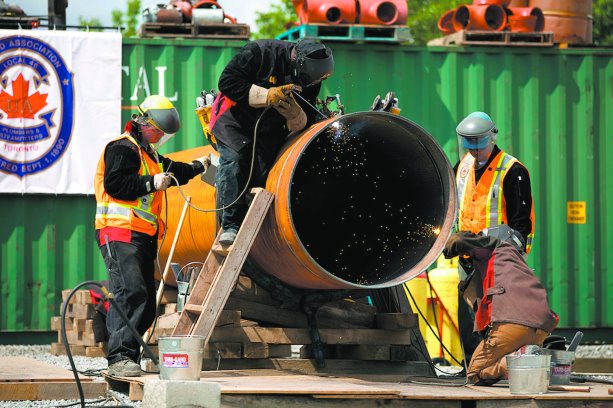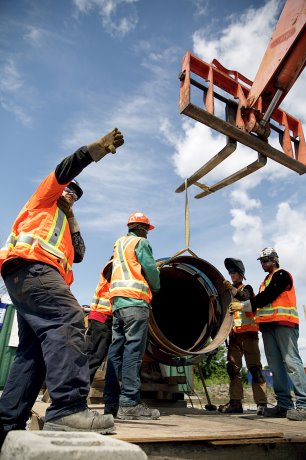The North American pipefitters union and TransCanada Corporation have joined forces to launched a unique training program that will prepare workers for upcoming projects across Canada by teaching them to use the most modern welding technology.
"They’ll be able to practice on 42-inch pipe, which no one can lay their hands on. It’s a major donation," said John Telford, Director of Canadian Affairs for the United Association of Journeymen and Apprentices of the Plumbing and Pipe Fitting Industry of the United States and Canada (UA).
"Right now what the training centres have been doing is they’ve been getting small pieces off of construction sites that were off a pipeline, there might be two or three pieces leftover of six or eight feet long."
TransCanada, and the company’s Energy East Pipeline Project team, donated 24 sections of 42"-diameter heavy-wall steel pipe that will be used for cutting and welding practice by hundreds of apprentices who have been accepted into the UA’s training and upgrading programs.
The pipe is being donated to UA locations in Edmonton, Winnipeg, Toronto, Thunder Bay, Ont., Sarnia, Ont., Montreal, Miramichi, N.B. and Dartmouth, N.S.
"From a resource and skill point of view, if you look ahead to 2016 and 2017, there’s going to be a lot of work, not just TransCanada, but other pipeline jobs, other infrastructure jobs in Ontario, mine, industrial work, and big commercial developments — we’re all going to be drawing on the skilled labour pool," said Bob Eadie, Energy East Pipeline Project Director, TransCanada.
"We’re trying to get going now, two years beforehand and start to reduce that gap and get skilled people that can do pipeline work such as this."
The proposed Energy East Pipeline will transport 1.1 million barrels of oil per day from Alberta and Saskatchewan to refineries and port terminals in Quebec and New Brunswick.
The $12-billion project involves the conversion of a portion of 3,000 kilometres of the Canadian Mainline to oil transportation and the construction of 1,600 km of new pipeline. It is expected to create more than 10,000 jobs during its development and construction.
Training opportunities exist for both apprentices and for experienced journeypersons who are not familiar with the 42-inch diameter.
"In the Miramichi area, we need to upgrade our welders. There’s no sense upgrading a guy welding pipe that’s going to be different than the pipe that he’s going to be asked to weld when he goes to work," said Telford.
"It’ll be a different weld procedure that these people have never done before; I think it’s going to open up apprentice welder positions in New Brunswick. Young kids are going to learn this technology. It’s going to be tremendous for the province of New Brunswick to get this thing approved."
Pipeline projects such as Energy East, Northern Gateway and Keystone will use automatic welding. While there will be some familiar with this kind of welding in Western Canada, but it will be the first in Eastern Canada, said Telford.
"It’s a machine that starts at the top of the pipe and rolls around the pipe to weld it. Once we get the machine running perfectly…every one of those joints will be x-rayed and what we find is that we’re probably having a less than 0.05 per cent repair rate on welds," he said.
With this donation, UA will be able to take some of the funding that it is saving on pipe and run more training programs.
"What we have to do now is that we have to prove that we have the best welders out there. If we do and we can show them the results on the job site, then we can get the work," said Telford.
Energy East is currently targeting the third quarter to file its application for the project. Eadie said the project’s stakeholder engagement program is as big as its technical engineering program.
"At this stage of the process, it’s the biggest element as we get ready to file the permit in Q3 and as we address the environmental issues. We have people out in the field looking at the impacts of flora, fauna and of course human habitat," he said.
He added that TransCanada is continually speaking with federal, provincial and local authorities and regularly meeting with First Nation communities.
Telford compared Energy East’s economic impact to that of the building of CP Rail.
"My guys have been going out to Alberta to work for 20 years and they’ve been doing all the right things to get that resource out of the ground and now it’s finally going to hit New Brunswick where they actually get to stay home and work on it," he said.
TransCanada plans to work with more unions to build on the labour pool across the country.
Follow Kelly Lapointe on Twitter @DCNKelly.












Recent Comments
comments for this post are closed